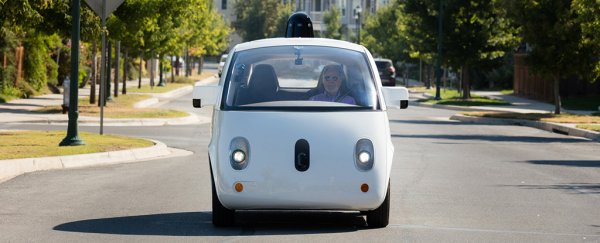Motion sickness on car trips is a long-standing problem, often affecting everyone but the driver. Since we'll all be passengers in self-driving cars it might soon become even more of an issue – and so scientists have come up with a newly patented system to try and keep nausea at bay.
The reason why many of us get car sick is thought to be the result of a conflict between our body's various senses, which can't decide if we're actually moving through space or sitting still. In effect, we are doing both at the same time.
What the new concept does is provides a series of light effects that mimic the outside world, telling the brain that we're zipping through space. It could even sit on your head like a pair of specs, according to the researchers from the University of Michigan who developed it.
"As we move toward autonomous vehicles, the interiors could also have an unusual configuration – it could be couches in a vehicle or you might be sitting backwards or sideways," says one of the team, Keith Hughes.
Keeping the outside world in view is thought to be one effective antidote to motion sickness, which is why drivers are usually less susceptible. But in the era of autonomous cars we're all more likely to be reading books or tapping away at laptops.
Any visual stimuli embedded into the anti-vomiting device will be synced to the car's speed, the researchers say, so passengers will always have some sense of the outside world in their peripheral vision even while they get on with something else.
While a pair of goggles is one way to get this technology into use, these artificial movement effects could be built into the frame of the car itself, as per the patent.
In fact the patent is pretty vague in its wording, so the central idea could be applied in a number of different ways, with various different types of light or stimuli.
And with around 50 percent of passengers thought to suffer from motion sickness to some extent, this system could be genuinely useful for large swathes of the population.
"In autonomous cars, everyone will be a passenger," says one of the researchers, Michael Sivak. "So you will have a larger potential pool of sick people. The protection that drivers have received from driving won't be there anymore."
The University of Michigan researchers aren't the only ones on the case. Last year Uber filed a patent of its own for a "Sensory Stimulation System", involving vibrating seats and blasts of air – all designed to give the sense of movement inside the cabin.
There's also mention of a light bar inside Uber's patent, so the brain can get notified of changes in speed and direction, and hopefully won't sent a message to the stomach to throw up its contents.
Whatever the solution, let's hope scientists work out how to keep us all feeling healthy and happy before the self-driving car revolution arrives, otherwise we might not be able to take advantage of all the potential benefits.
"The productivity gains that the proponents of self driving vehicles are talking about may not happen if we don't address the motion sickness problem," says Sivak.
The researchers are now speaking to manufacturers to get the technology embedded into self-driving cars. Meanwhile you can view the patent online.
